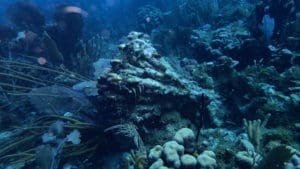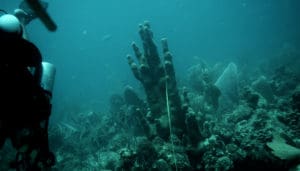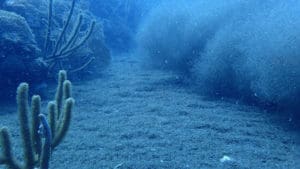
Looking at the plants and trees in the Virgin Islands, it’s possible to get a sense of how nature can recover from two category 5 hurricanes. Right after Hurricane Irma on Sept. 6 and Hurricane Maria on Sept. 19, it seemed almost impossible that hillsides stripped of every leaf would ever be green again. Four months later, even the most devastated northwest-facing slopes are becoming lush and verdant once more.
But what’s going on in the world below the surface of the sea? What’s happened to the coral reefs, and to the fish and other sea creatures that were first pummeled by storm surge and waves, then inundated with massive amounts of rainwater, some of it carrying toxic runoff?
That is a question fisheries biologist Jeff Miller hoped to begin to answer when he joined an expedition by boat around St. John to survey the hurricanes’ damage. Funded by the National Science Foundation, a team of 13 scientists spent 10 days in November studying sites within the Virgin Islands National Park, including one that had been part of a reef monitoring program since 1989.

Miller works for the National Park Service’s South Florida and Caribbean Inventory Monitoring Program, based in Miami, but he’s lived on St. John for 20 years. He knows the waters around St. John intimately, having completed thousands of dives as part of his work with the Park Service, and having set a record for circumnavigating the island as a swimmer in 2016.
The team is completing a detailed report of its findings, but Miller said the takeaway message is encouraging.
“Things aren’t as bad as I first feared they would be given the intensity of the storm on land.”
Some shallow reefs have been decimated, and snorkelers who regularly cruise certain reefs may be heartbroken by the damage, but reefs deeper than 20 feet have fared better.
“There are still beautiful reef structures – some that have been rearranged, but not catastrophically. Diving will be beautiful but different,” Miller said.
Team members primarily focused their study on three sites at the eastern end of St. John, Yawzi Point and Tektite on the south side of the island, and Mennebeck Bay on the north side. They also looked at a reef off Francis Bay on the north damaged by a mini cruise ship more than a dozen years ago. All these sites are relatively remote, which meant the effects of runoff from damaged septic tanks and chemicals let loose by the storm were minimal.
The severity of damage at the sites varied. At the southern side of Yawzi, the damage was worse.
“Sadly, the large Pillar Coral, [listed as threatened under the Endangered Species Act] that has been a prominent feature of this reef … was toppled and moved to the reef edge. It was also heavily damaged with white plague,” the report said.

White plague is a disease of unknown origin that has decimated reefs from Florida to Australia in the past several years. It has a long history in the Virgin Islands, according to Miller.
“First seen in 1998, it was the primary disease that caused large coral mortality between 2005 and 2007. At that time, 61.3 percent of the coral cover at our study sites died due to white plague that came after the coral bleaching.”
At Hawknest Bay, a popular beach on St. John’s north shore where stands of elkhorn coral have regrown after being heavily damaged by Hurricane Marilyn in 1995, Miller was cheered by what he saw.
“Yes, there was toppled coral, but many are still in an upright growth position. Given the shallowness of the reef, and the northwest face of the bay, that was encouraging.”
Miller said it’s difficult to predict what will be damaged by a storm underwater.
“It depends on the track and intensity of the storm, tides, wave heights, configuration of the bay, slope, and many other factors,” he said.
As a scientist, Miller tends to steer clear of generalities, and he was careful to emphasize that the study gave only “snapshots” of particular reefs on a particular day. But he did admit that “The overall impression is that the water clarity is poor.”
There’s a lot of “gunk” in the water which biologists call “marine snow,” Miller said. “We don’t know what it is. There are a lot of theories. We call it ‘small systems particles.’ Hopefully water movement will pick up, and the snow will clear out because it’s stressful for the reefs. It impedes the amount of sunlight which the coral reefs need to grow.”
The reefs are also being affected by the amount of organic material, such as leaves and branches, blown into the sea by wind or washed into the water by waves.

“It’s impressive in its volume. In places it’s inches thick,” said Miller. A snorkeler whose fin touches the bottom can stir up some of this material and unleash a cloud of organic material that make visibility decline to a matter of inches.
Perhaps the worst threat to the reef is the recent efflorescence of macro algae.
“Macro algae is a big problem because its growth is fast, and the growth of coral is slow. It out-competes coral for available space,” said Miller.
Scientists aren’t sure why the algae’s growth has been so sudden and robust.
“It could be a response to the high level of nutrients in the water from runoff, like putting Miracle-Gro on plants,” Miller said.
Macro algae can damage reefs in other ways, by abrading corals, by “shadowing” them from sunlight, and by harboring diseases and pathogens.
Miller and his colleagues have monitored the reefs around St. John for decades, and they’ve seen corals die from storm damage and from bleaching episodes – periods during which water warms beyond 85 degrees, causing energy-producing organisms living symbiotically within the coral to disappear.
“If the coral is not alive, if it’s not accreting—that is, laying down the skeleton in which the coral polyps grow—then other organisms move in and bio-erode the reef. Worms and sponges move in, weakening the framework,” said Miller.
“It’s similar to a house,” he continued. “If the shutters and roof stay intact during a storm, the house does well. If a shutter gives out, then the storm gets inside the structure, and there’s a lot of damage in that location. Fish need an intact reef structure. When a reef is crumbling, the fish go somewhere else.”
Miller said the study team did see some places where the reefs were intact, and they even saw spots where there was new growth.
“Every living coral is important, and it’s even more true now after the storms,” he said.
One of the benefits of the National Park, or any conservation area, is that “It can provide the best opportunity for recovery” following a disaster, Miller said.
“With a park, when a stress occurs, there’s less development and sedimentation stress than in other unprotected areas,” said Miller. These protected areas become nurseries that can seed other areas with new life. “When people come here snorkeling, they want to look at something.”
Shared content for Virgin Islands Source and St. John Tradewinds.





